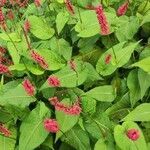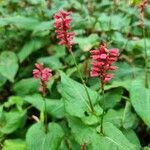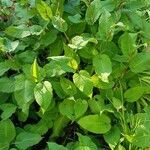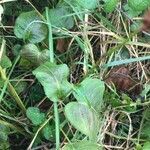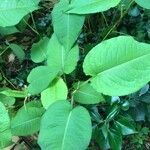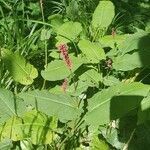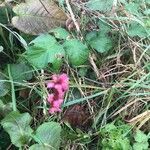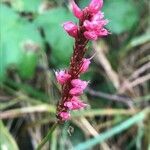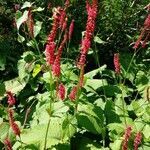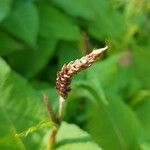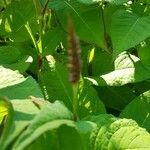Plants annual, 6-25 dm; roots not also arising from proximal nodes; rhizomes and stolons absent. Stems erect, simple or branched distally, usually ribbed, strigose or glabrescent proximally, pilose to hirsute distally. Leaves: ocrea brownish proximally, green distally, narrowly funnelform, 10-20 mm, chartaceous proximally, foliaceous distally, rarely chartaceous throughout, base inflated or not, margins truncate, ciliate with bristles 1-3 mm, surface densely strigose to hispid, not glandular-punctate; petiole 1-8.5(-14) cm, densely pilose to hirsute; blade without dark triangular or lunate blotch adaxially, ovate, 6-25(-30) × 3-17 cm, base cordate to truncate, margins scabrous to ciliate, apex acuminate, faces minutely strigose to densely hirsute, especially along veins abaxially, not glandular-punctate. Inflorescences mostly terminal, nodding or erect, uninterrupted, 10-150 × 8-18 mm; peduncle 20-100 mm, hirsute; ocreolae overlapping, margins ciliate with bristles 0.2-1 mm. Pedicels ascending to spreading, 1-4 mm. Flowers (1-)2-5 per ocreate fascicle, homostylous; perianth roseate to red, glabrous, not glandular-punctate, slightly accrescent; tepals 5, connate in proximal 1/3, obovate, 3-4.5 mm, veins prominent or not, not anchor-shaped, margins entire, apex obtuse to rounded; stamens 6-8, included or exserted; anthers pink or red, elliptic; styles 2, connate proximally. Achenes included, dark brown to black, discoid, 2.5-3.5 × 3-3.5 mm, shiny to dull, smooth to minutely granulate.
More
A herb which can grow each year from seed or keeps growing from year to year. It can grow in water or on land. It grows 1-2 m high and spreads 1-2 m wide. Young growth is very hairy. The stems are robust and finely hairy. The stem is 1-1.5 cm thick but slender in the upper part. It is often covered with grey hairs. The leaves are 6-25 cm long by 3.5-12 cm wide. They are oval and taper to the tip and have stalks. They are green and hairy on both surfaces. The flower spikes have 3-6 flowers and are 2-8 cm long and drooping. They occur in clusters at the ends of branches at the top of the plant. The flowers are 0.4 cm long and pink. The fruit is a small brown nut.
